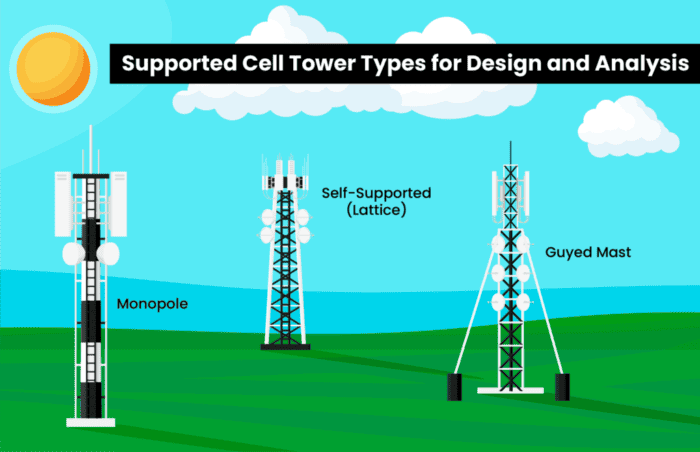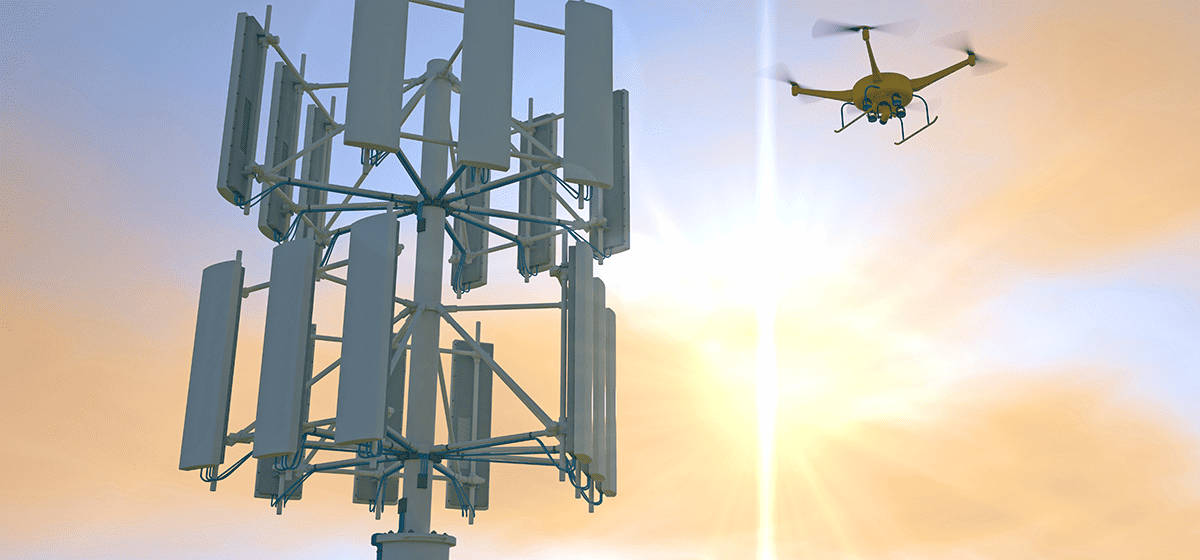Designing and analyzing telecommunications towers has traditionally been a complex and arduous process.
The tower types, positioning, load combinations, and analyzing the tower, mount, and foundation all must be considered. It’s also critical to abide by standards and codes to ensure safety, structural integrity, and compliance.
OpenTower Designer enables designers, engineers, and owner-operators to efficiently design, modify, manage, and maintain towers and validate their designs against multiple standards and codes – all within the same workflow and interface. The software includes features such as seismic and wind load generators to handle code specific load combinations. Users can make tower modifications, accurately position equipment, evaluate multiple scenarios, and perform foundation checks and connection designs.
Tower Type
OpenTower Designer supports three main types of towers:
- Monopoles (MP): Supports tapered, stepped, or hybrid designs.
- Self-Supported Towers (SST): Supports 3-leg and 4-leg lattice tower structures with a vast built-in library of face, plan, and hip bracing patterns.
- Guyed Masts: Supports 3-leg and 4-leg tower structures with an extensive library of face, plan, and cross-arm (torque arm) bracing patterns.
Design Codes
Design codes ensure safety, functionality, and compliance, providing a common framework and universal protocols for different industries. OpenTower Designer supports a range of global design codes from the following organizations and standards:
- Telecommunications Industry Association (TIA)
- Canadian Standards Association (CSA)
- Australian Standard (AS)
- British and European Standards (BS EN)
- Professional Lighting Guide (PLG)
Specific design codes are supported in OpenTower Designer depending on whether it is the Imperial version or Metric version of the software.
Design Codes Supported
| Features and Codes | OpenTower Imperial | OpenTower Metric |
| Monopole Reinforcement | Yes | No |
| Monopole Connections | Yes | No |
| TIA-222-H | Yes | Yes |
| TIA-222-G | Yes | Yes |
| TIA-222-F | Yes | Yes |
| AS 3995, AS 1170.2021, AS 4100 | No | Yes |
| CSA-S37–18 | No | Yes |
| Eurocode 3 UK NA | No | Yes |
| PLG07 (Monopoles) | No | Yes |
Tower Types Supported
| Tower Types | OpenTower Imperial | OpenTower Metric |
| TIA-222-H | MP, SST, and Guyed | MP, SST, and Guyed |
| TIA-222-G | MP, SST, and Guyed | MP, SST, and Guyed |
| TIA-222-F | MP, SST, and Guyed | MP, SST, and Guyed |
| AS 3995, AS 1170.2021, AS 4100 | – | SST and Guyed |
| CSA-S37–18 | – | MP (no fatigue), SST, and Guyed |
| Eurocode 3 UK NA | – | SST, and Guyed |
| PLG07 (Monopoles) | – | MP |
Features Supported Design Codes
| Features | OpenTower Imperial | OpenTower Metric |
| Foundation | TIA-222-H, TIA-222-G, TIA-222-F | TIA-222-H, TIA-222-G, TIA-222-F |
| Connections (Flange, Splice, and Base Plate) | TIA-222-H, TIA-222-G, TIA-222-F | TIA-222-H, TIA-222-G, TIA-222-F |
Tower Lifecycle with Multiple Scenarios
For many tower owners and carriers, they analyze towers to the most current code revision, regardless of the jurisdictionally adopted version of the International Building Code (IBC) standards. However, occasionally jurisdictions will not accept the most recent standard, therefore engineers must convert the model to the appropriate version as referenced in the jurisdiction’s adopted standard. This can be both time consuming and cumbersome and can quickly cut into margins when there are multiple scenarios to evaluate. Unless set up properly, the data is less reliable and error-prone if multiple files need to be updated and modeled individually to capture all the possible loading combinations.
With OpenTower Designer, efficiency and consistency is brought to the tower design approach. Its interface enables users to select from multiple load combinations (or grouping) of primary load cases at once. Through its unique scenario analysis capability, users can perform multiple structural analyses by combining different geometric modification layers with hierarchy, appurtenance group and configuration, and loading conditions. Once a scenario is created, OpenTower Designer generates an analytical model and presents the analysis results for the scenario. The scenario can then be saved in the model file for later reference, helping maintain historical data and the lifecycle of the structure in one file.
Saving Time and Eliminating Rework
For Tower Engineering Professionals, Inc. (TEP), a global telecommunications construction and engineering services company, its engineers were able to quickly set up 20 scenarios by inputting only a few wind definitions and properly labeling the existing, reserved, and proposed equipment during the initial model setup. With the feed line and discreet load modeling method used in the software, code changes were done by simply selecting the desired wind profile. This eliminated the use of multiple files and multiple changes within each of those files. As a result, they saved time and eliminated the need for rework. Similarly, when different loading combinations used the same design code, users were able to quickly select which carrier proposed loading to apply in the analysis and which carrier loading to leave off.









